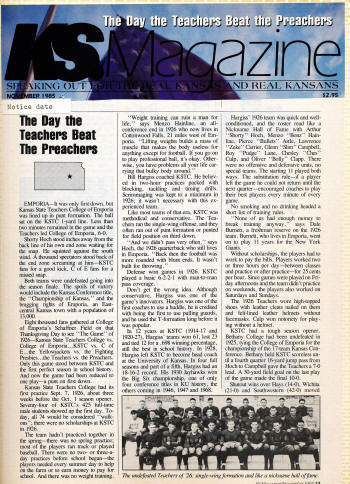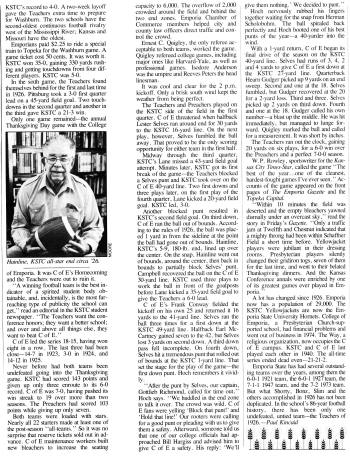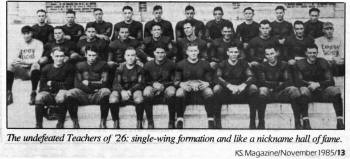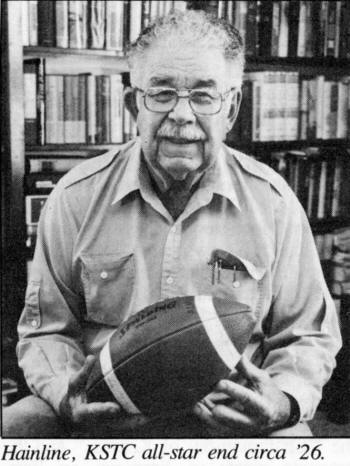|
|
 The
Day the Teachers Beat The Preachers
The
Day the Teachers Beat The Preachers
Nov. 1985, KS Magazine
EMPORIA—It was only
first down, but Kansas State Teachers College of Emporia was lined up in punt formation.
The ball sat on the KSTC 1-yard line. Less than two minutes remained in the game
and the Teachers led College of Emporia, 6-0.
Shorty Hoch stood inches away from the back line of his
own end zone waiting for the snap. He squinted against the south wind. A thousand
spectators stood back of the end zone screaming at him—KSTC fans for a good kick,
C of E fans for a missed snap.
Both teams were undefeated going into the season finale.
The spoils of victory would include the Kansas Conference title, the "Championship
of Kansas," and the bragging rights of Emporia, an East-central Kansas town with
a population of 13,000.
Eight thousand fans gathered at College of Emporia's Schaffner
Field on that Thanksgiving Day to see "The Game" of 1926—Kansas State Teachers College
vs. College of Emporia ... KSTC vs. C of E ... the Yellowjackets vs. the Fighting
Presbies ... the Teachers vs. the Preachers. Only this game stood between KSTC and
the first perfect season in school history. And now the game had been reduced to
one play—a punt on first down.
Kansas State Teachers College had its first practice Sept.
7, 1926, about three weeks before the Oct. 1 season opener. Seventy-four of KSTC's
425 full-time male students showed up the first day. Today, all 74 would be considered
"walk-ons"; there were no scholarships at KSTC in 1926.
The team hadn't practiced together in the spring—there
was no spring practice; most of the players ran track or played baseball. There
were no two- or three-a day practices before school began—the players needed every
summer day to help on the farm or to earn money to pay for school. And there was
no weight training.
"Weight training can ruin a man for life," says Menzo Hainline,
an all-conference end in 1926 who now lives in Cottonwood Falls, 21 miles west of
Emporia. "Lifting weights builds a mass of muscle that makes the body useless for
anything except for football. If you go on to play professional ball, it's okay.
Otherwise, you have problems all your life carrying that bulky body around. "
Bill Hargiss coached KSTC. He believed in two-hour practices
packed with blocking, tackling and timing drills. Scrimmaging was kept to a minimum
in 1926; it wasn't necessary with this experienced team.
Like most teams of that era, KSTC was methodical and conservative.
The Teachers ran the single-wing offense, and they often ran out of punt formation
or punted for field position on third down.
"And we didn't pass very often," says Hoch, the 1926 quarterback
who still lives in Emporia. "Back then the football was more rounded with blunt
ends. It wasn't built for throwing."
Defense won games in 1926. KSTC played a basic 6-2-2-1
with man-to-man pass coverage.
Don't get the wrong idea. Although conservative, Hargiss
was one of the game's innovators. Hargiss was one of the first coaches to use a
huddle, he is credited with being the first to use pulling guards, and he used the
T-formation long before it was popular.
In 12 years at KSTC (1914-17 and 1920-27), Hargiss' teams
won 61, lost 23 and tied 12 for a .698 winning percentage, still the best in school
history. In 1928, Hargiss left KSTC to become head coach at the University of Kansas.
In four full seasons and part of a fifth, Hargiss had an 18-16-2 record. His 1930
Jayhawks won the Big Six championship, one of only four conference titles in KU
history, the others coming in 1946, 1947 and 1968.
Hargiss' 1926 team was quick and well-conditioned, and
the roster read like a Nickname Hall of Fame with Arthur "Shorty" Hoch, Menzo "Bonz"
Hainline, Pierce "Bullets" Astle, Lawrence "Zeke" Carrier, Glenn "Slim" Campbell,
Roy "Pudge" Lane, Chesley "Cher" Culp, and Oliver "Bolly" Clapp. There were no offensive
and defensive units, no special teams. The starting 11 played both ways. The substitution
rule—if a player left the game he could not return until the next quarter—encouraged
coaches to play their best players every minute of every game.
No smoking and no drinking headed a short list of training
rules.
"None of us had enough money to break training anyway,"
says Dale Burnett, a freshman reserve on the 1926 team. Burnett, who lives in Emporia,
went on to play 11 years for the New York Giants.
Without scholarships, the players had to work to pay the
bills. Players worked two or three hours per day—between classes and practice or
after practice—for 25 cents per hour. Since games were played on Friday afternoons
and the team didn't practice on weekends, the players also worked on Saturdays and
Sundays.
The 1926 Teachers wore high-topped shoes with leather cleats
nailed on them and felt-lined leather helmets without facemasks. Culp won notoriety
for playing without a helmet.
KSTC had a tough season opener. Bethany College had been
undefeated in 1925, tying the College of Emporia for the championship of the 17-team
Kansas Conference. Bethany held KSTC scoreless until a fourth quarter 16-yard jump
pass from Hoch to Campbell gave the Teachers a 7-0 lead. A 30-yard field goal on
the last play of the game made the final 10-0.
Shutout wins over Hays (14-0), Wichita (21-0) and Southwestern
(42-0) moved KSTC's record to 4-0. A two-week layoff gave the Teachers extra time
to prepare for Washburn. The two schools have the second-oldest continuous football
rivalry west of the Mississippi River; Kansas and Missouri have the oldest.
Emporians paid $2.25 to ride a special train to Topeka
for the Washburn game. A game ticket cost 50 cents. It was worth it. KSTC won 35-0,
gaining 330 yards rushing and getting touchdowns from four different players. KSTC
was 5-0.
In the sixth game, the Teachers found themselves behind
for the first and last time in 1926. Pittsburg took a 3-0 first quarter lead on
a 45-yard field goal. Two touchdowns in the second quarter and another in the third
gave KSTC a 21-3 win.
Only one game remained—the annual Thanksgiving Day game
with the College
of Emporia. It was C of E's Homecoming and the Teachers were out to ruin it.
"A winning football team is the best indicator of a spirited
student body obtainable, and, incidentally, is the most far-reaching type of publicity
the school can get," read an editorial in the KSTC student newspaper. "The Teachers
want the conference honors; they want a better school; and over and above all things
else, they want to beat C of E. "
C of E led the series 18-15, having won eight in a row.
The last three had been close-14-7 in 1923, 3-0 in 1924, and 14-12 in 1925.
Never before had both teams been undefeated going into
the Thanksgiving game. KSTC had scored 143 points and given up only three en route
to its 6-0 record. C of E was 7-0, having pushed its win streak to 19 over more
than two seasons. The Preachers had scored 103 points while giving up only seven.
Both teams were loaded with stars. Nearly all 22 starters
made at least one of the post-season "all-teams. " So it was no surprise that reserve
tickets sold out in advance. C of E maintenance workers built new bleachers to increase
the seating capacity to 6,000. The overflow of 2,000 crowded around the field and
behind the two end zones. Emporia Chamber of Commerce members helped city and county
law officers direct traffic and control the crowd.
Ernest C. Quigley, the only referee acceptable to both
teams, worked the game. Quigley refereed college games, including major ones like
Harvard-Yale, as well as p rofessional
games. Isodore Anderson was the umpire and Reeves Peters the head linesman.
rofessional
games. Isodore Anderson was the umpire and Reeves Peters the head linesman.
It was cool and clear for the 2 p.m. kickoff. Only a brisk
south wind kept the weather from being perfect.
The Teachers and Preachers played on the KSTC side of the
field in the first quarter. C of E threatened when halfback Lester Selves ran around
end for 30 yards to the KSTC 16-yard line. On the next play, however, Selves fumbled
the ball away. That proved to be the only scoring opportunity for either team in
the first half.
Midway through the third quarter, KSTC's Lane missed a
43-yard field goal attempt. Minutes later, KSTC got its first break of the game—the
Teachers blocked a Selves punt and KSTC took over on the C of E 40-yard line. Two
first downs and three plays later, on the first play of the fourth quarter, Lane
kicked a 20-yard field goal. KSTC led, 3-0.
Another blocked punt resulted in KSTC's second field goal.
On third down, C of E ran the ball out of bounds. According to the rules of 1926,
the ball was placed 1 yard in from the sideline at the point the ball had gone out
of bounds. Hairline, KSTC's 5-9, 180-1b. end, lined up over the center. On the snap,
Hairline went out of bounds, around the center, then back in bounds to partially block Selves' punt. Campbell recovered the ball on the C of
E 30-yard line. KSTC used three plays to work the ball in front of the goalposts
before Lane kicked a 35-yard field goal to give the Teachers a 6-0 lead.
bounds to partially block Selves' punt. Campbell recovered the ball on the C of
E 30-yard line. KSTC used three plays to work the ball in front of the goalposts
before Lane kicked a 35-yard field goal to give the Teachers a 6-0 lead.
C of E's Frank Conway fielded the kickoff on his own 25
and returned it 16 yards to the 41-yard line. Selves ran the ball three times for
a first down at the KSTC 49-yard line. Halfback Earl McCartney gained seven to the
42, but Selves lost 3 yards on second down. A third down pass fell incomplete. On
fourth down, Selves hit a tremendous punt that rolled out of bounds at the KSTC
1-yard line. That set the stage for the play of the game—the first down punt. Hoch
remembers it vividly.
"After the punt by Selves, our captain, Gottlieb Richmond,
called for time out," Hoch says. "We huddled in the end zone to talk it over. The
crowd was wild. C of E fans were yelling 'Block that punt!' and `Hold that line!'
Our rooters were calling fora good punt or pleading with us to give them a safety.
Afterward, someone told us that one of our college officials had approached Bill
Hargiss and advised him to give C of E a safety. His reply: 'We'll
give them nothing.' We decided to punt."
Hoch nervously rubbed his fingers together waiting for
the snap from Herman Scholobohm. The ball spiraled back perfectly and Hoch booted
one of his best punts of the year—a 40-yarder into the wind.
With a 1-yard return, C of E began its final drive of the
season on the KSTC 40-yard line. Selves had runs of 3, 4, 2 and 4 yards to give
C of E a first down at the KSTC 27-yard line. Quarterback Hearn Gudger picked up
9 yards on an end sweep. Second and one at the 18. Selves fumbled, but Gudger recovered
at the 20 for a 2-yard loss. Third and three. Selves picked up 2 yards on third
down. Fourth and one at the 18. Gudger called his own number—a blast up the middle.
He was hit immediately, but managed to lunge forward. Quigley marked the ball and
called for a measurement. It was short by inches.
The Teachers ran out the clock, gaining 20 yards on six
plays, for a 6-0 win over the Preachers and a perfect 7-0-0 season.
W. P. Rowley, sportswriter for the Kansas City Times-Star,
called the game "The best of the year ... one of the cleanest, hardest-fought games
I've ever seen. " Accounts of the game appeared on the front pages of The Emporia
Gazette and the Topeka Capital.
"Within 10 minutes the field was deserted and the empty
bleachers yawned dismally under an overcast sky," read the story in Friday's Gazette.
"Only a traffic jam at Twelfth and Chestnut indicated that a mighty throng had been
within Schaffner Field a short time before. Yellowjacket players were jubilant in
their dressing rooms. Presbyterian players silently changed their gridiron togs,
seven of them for the last time, and went to their belated Thanksgiving dinners.
And the Kansas Conference annals were enriched by one of its greatest games ever
played in Emporia. "
A lot has changed since 1926. Emporia now has a population
of 29,000. The KSTC Yellowjackets are now the Emporia State University Hornets.
College of Emporia, a Presbyterian Church-supported school, had financial problems
and went out of business in 1974. The Way, a religious organization, now occupies
the C of E campus. KSTC and C of E last played each other in 1940. The all-time
series ended dead even-21-21-2.
Emporia State has had several outstanding teams over the
years, among them the 6-0-1 1921 team, the 6-0-1 1927 team, the 7-1-1 1947 team,
and the 7-2 1973 team. But what Shorty, Bonz, Slim, and the others accomplished
in 1926 has not been duplicated. In the school's 86-year football history, there
has been only one undefeated, untied team—the Teachers of 1926. —Paul Kincaid